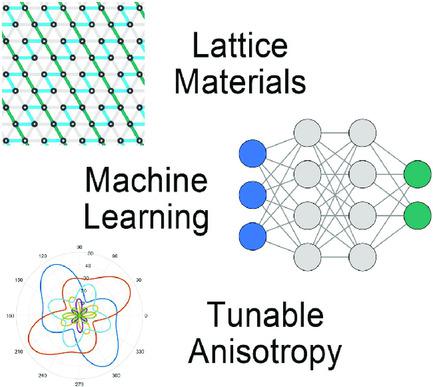当前位置:
X-MOL 学术
›
Adv. Eng. Mater.
›
论文详情
Our official English website, www.x-mol.net, welcomes your
feedback! (Note: you will need to create a separate account there.)
Architectured Lattice Materials with Tunable Anisotropy: Design and Analysis of the Material Property Space with the Aid of Machine Learning
Advanced Engineering Materials ( IF 3.4 ) Pub Date : 2020-10-13 , DOI: 10.1002/adem.202001069 Roman Kulagin 1 , Yan Beygelzimer 2 , Yuri Estrin 1, 3 , Artem Schumilin 4 , Peter Gumbsch 5, 6
Advanced Engineering Materials ( IF 3.4 ) Pub Date : 2020-10-13 , DOI: 10.1002/adem.202001069 Roman Kulagin 1 , Yan Beygelzimer 2 , Yuri Estrin 1, 3 , Artem Schumilin 4 , Peter Gumbsch 5, 6
Affiliation

|
Architectured beam lattice materials whose anisotropy can be tuned by varying the composition of their elementary cell are investigated. As an exemplary prototype of such material architecture, a regular triangular lattice with an elementary cell composed of 12 beams is considered. One out of three possible values of the elastic modulus is assigned to each beam. The structure is fully defined by a vector in the 12D composition‐structure space whose components are given by the elastic modulus values of the beams comprising the elementary cell. The elastic properties of this 2D material are represented by the compliance elasticity tensor with six independent compliance coefficients. Aiming at a specific set of properties thus involves finding the point in the 12D composition‐structure space that corresponds to a given point in the 6D property space. This is a problem of large dimensionality. To solve it, the neural network approach is used. This enables creation of architectured materials with tunable elastic anisotropy. A chiral element combining large twist with additional anisotropy requirements is presented as an example of successful machine‐learning‐based optimization of beam lattices proposed.
中文翻译:

具有可调各向异性的体系结构格形材料:借助机器学习对材料特性空间进行设计和分析
研究了可以通过改变其基本单元的组成来调整其各向异性的建筑束晶格材料。作为这种材料结构的示例性原型,考虑了具有由12个光束组成的基本单元的规则三角形晶格。弹性模量的三个可能值之一分配给每个梁。该结构完全由12D组成结构空间中的矢量定义,其矢量由组成基本单元的梁的弹性模量值给出。这种2D材料的弹性特性由具有六个独立柔量系数的柔量弹性张量表示。因此,针对一组特定的属性需要在12D合成结构空间中找到与6D属性空间中给定点相对应的点。这是大尺寸的问题。为了解决这个问题,使用了神经网络方法。这使得能够创建具有可调弹性各向异性的建筑材料。提出了一个将大扭曲与附加各向异性要求相结合的手性元素,作为成功提出的基于机器学习的梁格优化示例。
更新日期:2020-12-18
中文翻译:

具有可调各向异性的体系结构格形材料:借助机器学习对材料特性空间进行设计和分析
研究了可以通过改变其基本单元的组成来调整其各向异性的建筑束晶格材料。作为这种材料结构的示例性原型,考虑了具有由12个光束组成的基本单元的规则三角形晶格。弹性模量的三个可能值之一分配给每个梁。该结构完全由12D组成结构空间中的矢量定义,其矢量由组成基本单元的梁的弹性模量值给出。这种2D材料的弹性特性由具有六个独立柔量系数的柔量弹性张量表示。因此,针对一组特定的属性需要在12D合成结构空间中找到与6D属性空间中给定点相对应的点。这是大尺寸的问题。为了解决这个问题,使用了神经网络方法。这使得能够创建具有可调弹性各向异性的建筑材料。提出了一个将大扭曲与附加各向异性要求相结合的手性元素,作为成功提出的基于机器学习的梁格优化示例。











































 京公网安备 11010802027423号
京公网安备 11010802027423号